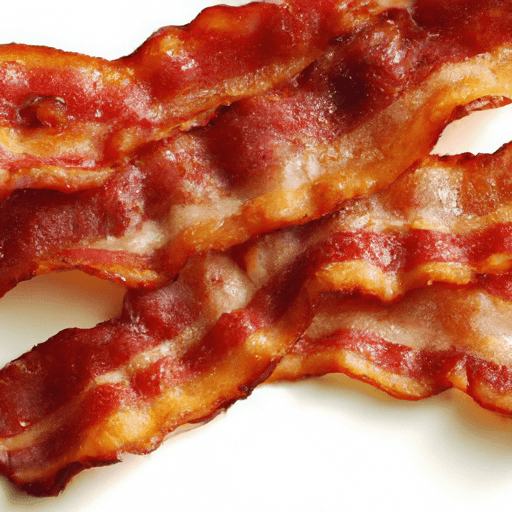The Allure of the Crispy Bacon Strip: A Delightful Culinary Treasure
Few culinary delights can match the indulgent pleasure of savoring a perfectly cooked bacon strip. Its enticing aroma fills the room, awakening the senses and stimulating the appetite. Whether enjoyed in a hearty breakfast, a gourmet sandwich, or as a flavorful addition to a decadent dish, the cooked bacon strip offers a symphony of flavors that delight the palate.
The Taste of Perfection
When cooked to perfection, a bacon strip boasts irresistibly crisp edges, which give way to a tender, smoky interior. With every bite, you experience a delightful contrast of textures: the satisfying crunch followed by the rich, melt-in-your-mouth meatiness. The combination of saltiness and smokiness tantalizes your taste buds and leaves you longing for just one more bite.
Versatile Culinary Applications
The allure of the cooked bacon strip lies not only in its sensational taste but also in its remarkable versatility. Renowned for its ability to enhance the flavor profile of countless dishes, bacon has earned its place as a kitchen staple.
For breakfast enthusiasts, cooked bacon strips are the star of the show. They complement pancakes, waffles, and eggs masterfully while infusing each bite with their distinct magic. A classic BLT sandwich owes much of its popularity to the salty, savory heaven that bacon provides.
In the world of culinary creativity, bacon shines as a versatile ingredient that adds a burst of flavor to savory dishes. Wrapped around succulent meat, such as chicken or filet mignon, it elevates the dish to new heights. Its rich, smoky essence also complements pasta dishes, salads, and even desserts. It’s not uncommon to find candied bacon adorning creamy desserts or adding a unique twist to chocolate treats.
Nutritional Value
While the cooked bacon strip undeniably tantalizes the taste buds, it’s worth considering its nutritional composition. Bacon, a pork product, is primarily composed of fat and protein. As with most high-fat foods, moderation is key to enjoying its flavors guilt-free.
A typical cooked bacon strip provides approximately 42 calories, making it a relatively calorie-dense food. However, it also offers a decent protein content, contributing to a feeling of satiety. A single strip yields around 3 grams of protein, but it’s essential to remember that bacon’s fat content is significantly higher.
A Brief Glimpse into Bacon’s History and Facts
The love affair between humanity and bacon dates back centuries. Origins of bacon can be traced to ancient Rome, where the technique of salt-curing pork belly emerged. Throughout history, different cultures have developed their own versions of this beloved food.
In the United States, bacon gained prominence in the early 20th century, becoming a breakfast staple enjoyed by millions. The American variety is typically made of pork belly, while European counterparts, like the British or Canadian bacon, may come from different cuts of meat.
Interestingly, the term “bacon” has expanded beyond traditional swine products. Today, you can find variations made from turkey, beef, and even plant-based alternatives. Regardless of the source, these alternatives aim to capture the irresistible and characteristic essence bacon has to offer.
Unleash the Bacon Strip’s Potential in Your Kitchen
Diving into the world of cooking offers an opportunity to explore the enticing possibilities that cooked bacon strips offer. The smoky, crispy sensation can transform a dish from ordinary to extraordinary. Be it a lazy weekend breakfast or an elaborate dinner party, the addition of bacon brings a touch of indulgence and delight to any occasion.
So, go ahead, embrace the allure of the cooked bacon strip. Experiment with recipes, satisfying your cravings while tantalizing your taste buds. Let the sizzle of bacon in the skillet transport you to a realm of culinary wonder. Whether enjoyed plain or as an ingredient in a mouth-watering creation, this culinary treasure is sure to fill your kitchen with both flavor and joy.
Origin:
- Bacon is believed to have originated from China around 1500 BCE, where pork belly was salted and cured with spices.
- The name “bacon” is derived from the Old High German word “bakko,” which referred to the back of the pig.
Common Uses:
- Cooked bacon strips are widely used as a popular ingredient in breakfast dishes such as bacon and eggs, bacon sandwiches, and bacon-wrapped ingredients.
- It is also used as a topping for salads, burgers, pizzas, and various other dishes to add a smoky and savory flavor.
Nutritional Benefits:
- Cooked bacon strips are a good source of protein, providing about 3 grams per slice.
- They also contain important vitamins and minerals like niacin, vitamin B12, zinc, and selenium.
- However, it’s worth noting that bacon is high in saturated fat and sodium, so it should be consumed in moderation as part of a balanced diet.
Unique Properties and Historical Significance:
- The process of curing and smoking bacon has been used for centuries to preserve meat.
- Different countries and regions have their own unique methods of making bacon, resulting in variations in flavor, texture, and appearance.
- Bacon achieved its peak popularity in the United States during the early 20th century and has remained a beloved ingredient ever since.




Use the share button below if you liked it.
It makes me smile, when I see it.